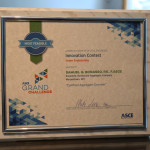 A tire reuse technology, Confined Aggregate Concrete, recently won the first American Society of Civil Engineers (ASCE) Grand Challenge Infrastructure Innovation Contest for most feasible green engineering idea.
A tire reuse technology, Confined Aggregate Concrete, recently won the first American Society of Civil Engineers (ASCE) Grand Challenge Infrastructure Innovation Contest for most feasible green engineering idea.
Confined Aggregate Concrete is sold as Mechanical Concrete® and is a geosynthetic technology that confines any crushed stone or aggregate material inside of a thin-walled cylinder. This confinement dramatically improves the load supporting capacity of the stone. It is “green” because in its most economical configuration, it reuses one of society’s most high-quality industrial products: used/waste automotive tires. Confinement makes stone particles several times stronger than conventional compacted stone.
“The ASCE Grand Challenge is a ten year effort to reduce the life cycle cost of infrastructure by 50 percent by 2025 and foster the optimization of infrastructure investments for society,” said Gerald E. Buckwalter, Northrop Grumman director of strategic development and innovation forum committee chair.
“The Innovation contest was one of the efforts connected to the Grand Challenge and participation has helped ASCE start its journey toward improving our nation’s infrastructure.”
Terry Neimeyer, PE, CEO of KCI Technologies, a national engineering firm from Baltimore, Md., presented the award at the ASCE Innovation Contest Green Engineering Event in Reston, Va., May 18. KCI senior engineering personnel participated in the green engineering selection process.
Samuel G. Bonasso, PE, a Fellow of ASCE and president of the Reinforced Aggregates Company, discovered Confined Aggregate Concrete in 2004 while looking for a better way to dispose of waste tires and received a U.S. patent for the technology in 2008.
“People of all types, from engineers to the guy next door, have been trying to figure out what to do with waste auto tires for a long time,” Bonasso said. “So this was a giant step in the right direction.
“By removing both sidewalls from a wasted automotive tire, a rugged and low cost tire-derived-geo-cylinder is created. Worldwide, modern societies generate nearly 1.4 billion wasted automotive tires a year (300 million in the U.S. alone).
“We lab tested this technology, and it has been field proven on West Virginia coal haul roads and for use in constructing highway bases and shoulders. It can also be used for earth retaining walls, bridge abutments, slope and channel erosion protection and storm water retention.”
Currently, Mechanical Concrete® is being used in 30 projects in five states. In the field, it has reduced maintenance on gravel surfaced public and industrial roads by 75%.
“Most road surface failures are caused by water penetrating into the compacted base-stone binder causing it to fall apart,” Bonasso said. “This causes road edge collapse, pot holes, ruts and creates safety problems for divers.
“Mechanical Concrete®, when laid down ‘round-to-the-eye,’ physically confines and holds the base stone together. This process consistently creates a virtually indestructible, water permeable base course without depending on adhesives, binders or friction. It is fast, uses small equipment and instantly supports loads and resists erosion.”
Confined Aggregate Concrete is an open source outside of the U.S. and Canada and can assist the developing world in creating a viable, four season, farm-to-market road system without modern construction technology.
Bonasso graduated in civil engineering from the University of Miami, Fla., and West Virginia University. He is an inventor with five U.S. and Canadian patents and is a career civil engineering consultant and structural engineer. He has also served publically as the West Virginia Secretary of Transportation and Deputy Administrator, Research and Special Programs Administration and USDOT, Washington.



